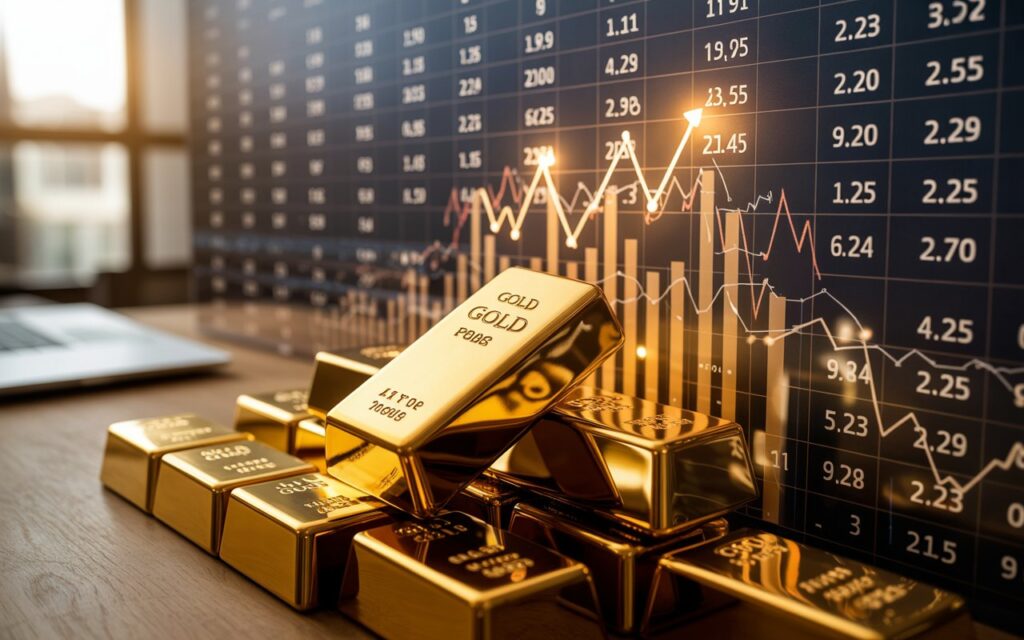
A Year of Extraordinary Growth
The year 2025 has been nothing short of historic for gold. Starting the year at $2,623.91 per ounce, the yellow metal staged a spectacular climb to a record high of $4,371.78 per ounce by October 20, 2025, marking a 66.6% year-to-date gain according to exchange-rates.org. By October 30, gold was still trading around $4,013 per ounce, maintaining an impressive lead of over 50 percent from the start of the year. Few asset classes have matched this kind of performance, making gold the standout performer of 2025.
This remarkable rally did not occur in isolation. It was fueled by a perfect storm of central bank accumulation, rising geopolitical risks, Federal Reserve rate cuts, surging investor inflows, and a weaker US dollar. These forces combined to create an environment where gold thrived as both a hedge and a high-performing asset. Let us take a deep dive into each driver behind this rally and what made 2025 such a defining year for gold.
1. Central Bank Purchases Reach Record Levels
One of the biggest catalysts for gold’s rally in 2025 was relentless central bank buying. According to JPMorgan, global central banks purchased between 900 and 1,000 tonnes of gold during the year, marking the third consecutive year of net additions exceeding 1,000 tonnes. Countries such as China, Poland, and Kazakhstan were particularly active in accumulating gold reserves.
The motivation behind this wave of purchases was twofold. First, many emerging market economies sought to diversify away from US dollar reserves, especially after years of dollar strength and geopolitical tensions surrounding sanctions. Second, gold’s reliability as a store of value became increasingly attractive amid volatile global markets.
The People’s Bank of China, for instance, continued its aggressive acquisition campaign, adding to its reserves for 23 consecutive months. This consistent buying spree reflected a broader strategic realignment among global policymakers who wanted to reduce dependence on dollar assets. As a result, central banks collectively became a powerful tailwind for gold prices, ensuring steady demand even when speculative sentiment fluctuated.
2. Geopolitical and Trade Risks Drive Safe-Haven Demand
Geopolitical instability has long been a core driver of gold demand, and 2025 amplified this dynamic. The return of Donald Trump’s trade tariffs, including a 100% tariff on Chinese imports, reignited fears of a new trade war between the world’s two largest economies. These tensions quickly spilled over into currency markets, stock indices, and global trade flows, prompting investors to flock to gold as a safe haven.
Additionally, recurring US government shutdown threats, military escalations in Eastern Europe and the South China Sea, and renewed tensions in the Middle East kept global risk appetite subdued. According to JPMorgan, geopolitical uncertainty directly boosted safe-haven allocations in institutional portfolios throughout 2025.
For retail investors, headlines surrounding political standoffs, trade disputes, and the potential for economic slowdown all reinforced the appeal of holding tangible assets like gold. This surge in sentiment-driven demand magnified the impact of already robust institutional buying, contributing to sustained upward pressure on prices.
3. The Role of Lower Real Yields and Federal Reserve Policy
Perhaps the most decisive macroeconomic driver of 2025’s gold surge was monetary policy. After maintaining high interest rates through 2024 to combat inflation, the Federal Reserve began cutting rates in mid-2025, eventually bringing the federal funds rate to a target range of 3.75–4%. The central bank also announced the end of quantitative tightening (QT) by December 1, injecting liquidity into financial markets.
Lower interest rates reduce the opportunity cost of holding gold, which does not yield income like bonds or savings accounts. Historically, every major Fed easing cycle has benefited gold, as shown in multiple past episodes:
| Period | Fed Cuts | Gold Performance (12–24 months later) | Source |
|---|---|---|---|
| 2000–2002 | 6.5% to 1% | +30% | auronum.co.uk |
| 2007–2008 | Pre-GFC cuts | Major rally before crisis | auronum.co.uk |
| 2019–2020 | 2.25% to 0% | +50% | auronum.co.uk |
| Average (7 cycles) | – | +11% (1-year), 6/7 positive | forex.com |
The same pattern repeated in 2025. As real yields declined, gold became increasingly attractive, particularly to large asset managers seeking portfolio diversification amid falling bond returns. Analysts from gold.org estimated that this shift alone accounted for a significant portion of 2025’s midyear rally.
By October 29, markets were pricing in another potential rate cut in December with 50% probability, according to economictimes.indiatimes.com. This anticipation provided further tailwind for gold’s price momentum into the final quarter.
4. ETF and Investor Inflows Reach Record Highs
Investor behavior in 2025 also reflected strong conviction in the gold trade. According to Morgan Stanley, global ETF inflows reached approximately $26 billion in the third quarter alone, the highest level in more than a decade.
Chinese households and institutional investors were particularly aggressive buyers, with gold ETFs in Shanghai and Shenzhen seeing record subscription volumes. In Western markets, renewed interest in precious metals was evident as funds and retail traders diversified away from equities, which had become increasingly volatile amid political and monetary uncertainty.
By mid-October, cumulative inflows into gold-backed ETFs surpassed those of 2020, when the pandemic drove similar levels of fear-based buying. This time, however, the demand was driven by structural factors such as sustained central bank activity, weaker currencies, and longer-term inflation concerns.
5. The Impact of a Weaker US Dollar
Gold’s 2025 rally also coincided with notable US dollar weakness. The DXY index fell throughout the year as investors reacted to lower interest rates and widening US fiscal deficits. According to gold.org, this decline made gold cheaper for non-US buyers, spurring additional demand from Europe and Asia.
A weaker dollar tends to lift gold because the two assets are inversely correlated. As the greenback depreciated, foreign investors took advantage of lower relative prices, contributing to the global surge in demand. For emerging markets, where local currencies often depreciate against the dollar, holding gold became a prudent way to preserve wealth amid exchange rate volatility.
6. Year-to-Date Performance and Market Sentiment
By the end of October 2025, gold had delivered between 52% and 67% returns year-to-date, achieving 45 new all-time highs in less than ten months. This performance outpaced major equity indices, real estate, and most commodities.
The rally was not just a reflection of fear or speculation; it represented a broader recognition that gold remains a cornerstone asset for stability in uncertain times. Hedge funds, sovereign wealth funds, and individual investors all played a part in creating one of the strongest multi-month rallies in recent history.
Market sentiment has remained bullish but increasingly cautious. Many analysts consider the 8–9% correction from the October 20 high ($4,372 to ~$4,013) as a healthy and necessary consolidation phase following a steep seven-week rally of over 27%.
7. Technical View: Support and Resistance Levels
From a technical perspective, gold remains in a long-term uptrend. Key support zones are identified between $3,970 and $3,900, corresponding to Fibonacci retracement levels of 38% – 50% from the October peak. If these zones hold, analysts expect the next leg higher to target $4,400 – 4,500 in early 2026.
Momentum indicators such as RSI and MACD suggest temporary cooling, but the broader structure remains bullish. The correction seen in late October is consistent with past behavior in long bull markets, where pauses often precede another upward wave.
8. Historical Context: Post-Rally Corrections
Gold’s behavior in 2025 also aligns with historical precedents. Major rallies in gold have often been followed by short-term corrections before resuming their upward trajectory. For example:
| Historical Rally | Peak Gain | Correction | Duration | Recovery Pattern |
|---|---|---|---|---|
| 1980 Bull | +126% in 8 weeks | -65% | Prolonged | Multi-year |
| 2011 ATH | +659% (2000–2011) | -40% | Multi-year | Gradual |
| 2020 Rally | +50% to $2,070 | -18% | Months | Quick |
| Average Major Bulls | – | 20% | 4.7 months | Full recovery |
According to investing.com and discoveryalert.com.au, the typical correction during strong bull markets ranges from 11% to 30%. Based on this pattern, the current 8–9% decline could extend modestly toward $3,500 – $3,900, still consistent with a healthy trend continuation. The presence of sustained central bank demand and rate cuts provides a strong buffer against deeper declines.
9. The Bigger Picture: 2025 as a Turning Point
In many ways, 2025 has redefined gold’s role in the global economy. Once considered a defensive asset used mainly in crises, gold has now evolved into a strategic reserve and investment asset favored by both institutions and governments.
The combination of structural changes in global finance, diversification away from the dollar, and renewed emphasis on tangible reserves suggests that the current bull cycle may still have considerable room to run. Analysts agree that 2025 marked not just a rally but a revaluation of gold’s place in modern portfolios.
10. Conclusion
Gold’s journey through 2025 has been a reflection of shifting global paradigms. From the record central bank purchases and Fed rate cuts to the resurgence of geopolitical uncertainty, every factor has converged to push prices to unprecedented heights.
Despite a brief pullback from the all-time high of $4,371.78, gold remains fundamentally strong. With robust demand, favorable monetary conditions, and continuing diversification trends, the outlook for gold heading into 2026 remains bullish. The year 2025 will likely be remembered as the year gold reasserted its dominance as the ultimate store of value and a trusted hedge against global uncertainty.
Cautionary Investor Perspective: Patience Over Pursuit
While the broader outlook for gold remains constructive, I believe it is vital to approach this market with restraint and discipline. As a cautious and fundamentally conservative investor, I have never favored buying into any asset at or near its all-time highs – especially when that asset is non-producing and derives its value primarily from sentiment, scarcity, or macroeconomic conditions rather than cash flow.
Gold’s recent performance has been undeniably impressive, supported by rate cuts, inflationary pressures, a weaker dollar, and rising fiscal deficits. Yet, history consistently teaches that even the strongest bull markets experience corrections, often sharper and more prolonged than many expect. The temptation to chase momentum at elevated prices is one of the most common pitfalls investors face.
In my view, the prudent approach is clear: avoid buying into peaks and wait patiently for weakness. Gold should be accumulated only during meaningful corrections, when euphoria fades and value re-emerges. Even in such phases, I advocate buying in small, measured quantities, ensuring that exposure remains manageable and in line with one’s broader portfolio strategy.
It is worth remembering that gold, while a reliable store of value, does not generate income or yield. Therefore, overcommitting capital to a non-producing asset during exuberant phases can compromise liquidity and reduce flexibility should market conditions change abruptly.
In essence, my guidance is one of caution and composure. Despite supportive fundamentals, chasing gold after a vicious bull run carries inherent risks. True opportunity lies not in joining the crowd at euphoric peaks but in exercising patience when markets eventually cool. Long-term success often favors those who buy when others hesitate, not when others rush in.


